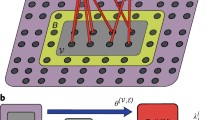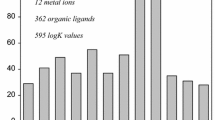Abstract
The performances of a log P model designed from EVA descriptors based on theoretically derived normal coordinate frequencies and using the classical PLS analysis as statistical engine were compared to those provided by a neural network model employing various autocorrelation vectors for describing the molecules. The superiority of the latter is clearly demonstrated for simulating the lipophilicity of simple chemical structures.
Similar content being viewed by others
References
Berthelot, M., Ann. Chim. Phys., 26 (1872) 408.
Overton, E., Studien über die Narkose zugleich ein Beitrag zur allgemeinen Pharmakologie, Verlag von Gustav Fischer, Jena, 1901.
Hansch, C. and Leo, A., Exploring QSAR. Fundamentals and Applications in Chemistry and Biology, ACS Professional Reference Book, American Chemical Society, Washington, DC, 1995.
Sangster, J., Octanol—Water Partition Coefficients: Fundamentals and Physical Chemistry, Wiley, Chichester, 1997.
Reinhard, M. and Drefahl, A., Handbook for Estimating Physicochemical Properties of Organic Compounds, Wiley, New York, NY, 1999.
Rekker, R.F. and Mannhold, R., Calculation of Drug Lipophilicity. The Hydrophobic Fragmental Constant Approach, VCH, Weinheim, 1992.
Klopman, G., Li, J.-Y., Wang, S. and Dimayuga, M., J. Chem. Inf. Comput. Sci., 34 (1994) 752.
Meylan, W.M. and Howard, P.H., J. Pharm. Sci., 84 (1995) 83.
Klopman, G. and Iroff, L.D., J. Comput. Chem., 2 (1981) 157.
Basak, S.C., Gute, B.D. and Grunwald, G.D., J. Chem. Inf. Comput. Sci., 36 (1996) 1054.
Devillers, J., Domine, D. and Karcher, W., SAR QSAR Environ. Res., 3 (1995) 301.
Bodor, N. and Huang, M.J., J. Pharm. Sci., 81 (1992) 272.
Bodor, N., Huang, M.J. and Harget, A., J. Mol. Struct. (THEOCHEM), 309 (1994) 259.
Domine, D., Devillers, J. and Karcher, W., In Devillers, J. (Ed.) Neural Networks in QSAR and Drug Design, Academic Press, London, 1996, pp. 47–63.
Schaper, K.J. and Samitier, M.L.R., Quant. Struct.—Act. Relat., 16 (1997) 224.
Devillers, J., Domine, D., Guillon, C., Bintein, S. and Karcher, W., SAR QSAR Environ. Res., 7 (1997) 151.
Devillers, J. and Domine, D., SAR QSAR Environ. Res., 7 (1997) 195.
Devillers, J., Domine, D. and Guillon, C., Eur. J. Med. Chem., 33 (1998) 659.
Devillers, J., Domine, D., Guillon, C. and Karcher, W., J. Pharm. Sci., 87 (1998) 1086.
Devillers, J., Analusis, 27 (1999) 23.
Devillers, J., SAR QSAR Environ. Res., 10 (1999) 249.
Ferguson, A.M., Heritage, T., Jonathon, P., Pack, S.E., Phillips, L., Rogan, J. and Snaith, P.J., J. Comput.-Aided Mol. Design, 11 (1997) 143.
Ginn, C.M.R., Turner, D.B., Willett, P., Ferguson, A.M. and Heritage, T.W., J. Chem. Inf. Comput. Sci., 37 (1997) 23.
Tuppurainen, K., SAR QSAR Environ. Res., 10 (1999) 39.
Moreau, G. and Broto, P., Nouv. J. Chim., 4 (1980) 359.
Moreau, G. and Broto, P., Nouv. J. Chim., 4 (1980) 757.
Devillers, J., In Devillers, J. and Balaban, A.T. (Eds.) Topological Indices and Related Descriptors in QSAR and QSPR, Gordon and Breach, The Netherlands, 1999, pp. 595–612.
Devillers, J., Domine, D. and Chastrette, M., In Proceedings of QSAR92, July 19-23, 1992, Duluth, MN, U.S.A., p. 12.
Hansen, L.K. and Salamon, P., IEEE Trans. Pattern Anal.Machine Intell., 12 (1990) 993.
The model has been implemented in AUTOLOGPTM (v. 4.0), a user-friendly software program running on IBMTM and compatible PC underWindowsTM 3.1 andWindowsTM 95.
Hair, J.F., Anderson, R.E., Tatham, R.L. and Black, W.C., Multivariate Data Analysis with Readings, Macmillan, New York, NY, 1992.
Hansch, C., Leo, A. and Hoekman, D., Exploring QSAR. Hydrophobic, Electronic, and Steric Constants, ACS Professional Reference Book, American Chemical Society, Washington, DC, 1995.
Hansch, C., In Devillers, J. (Ed.) Comparative QSAR, Taylor and Francis, Philadelphia, PA, 1998, pp. 285–368.
Author information
Authors and Affiliations
Rights and permissions
About this article
Cite this article
Devillers, J. EVA/PLS versus autocorrelation/neural network estimation of partition coefficients. Perspectives in Drug Discovery and Design 19, 117–131 (2000). https://doi.org/10.1023/A:1008771606841
Issue Date:
DOI: https://doi.org/10.1023/A:1008771606841




